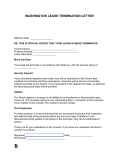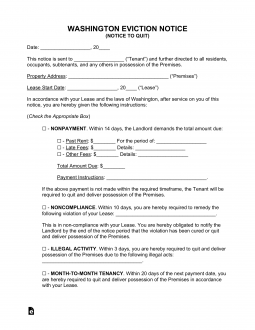Updated April 10, 2024
A Washington eviction notice is a form used by a landlord to initiate the eviction process with a tenant due to a violation of the lease agreement. The notice includes a description of the violation committed by the tenant and how they can cure the issue. If the tenant refuses, the landlord can file an Unlawful Detainer Action in the Superior Court.
By Type (4)
 14-Day Notice to Quit (Non-Payment) – This notice form is used when a tenant fails to pay rent when it is due. The landlord must give the tenant 14 days to pay before moving forward with the eviction. 14-Day Notice to Quit (Non-Payment) – This notice form is used when a tenant fails to pay rent when it is due. The landlord must give the tenant 14 days to pay before moving forward with the eviction.
Download: PDF, MS Word, OpenDocument |
 10-Day Notice to Quit (Non-Compliance) – This form is used when a tenant is breaching the lease for reasons other than the non-payment of rent or illegal activity. A landlord must give the tenant 10 days to rectify the problem before eviction proceedings can begin. 10-Day Notice to Quit (Non-Compliance) – This form is used when a tenant is breaching the lease for reasons other than the non-payment of rent or illegal activity. A landlord must give the tenant 10 days to rectify the problem before eviction proceedings can begin.
Download: PDF |
 3-Day Notice to Quit (Illegal Activity) – This notice is given to tenants if they engage in illegal activity. Once delivered to the tenant, the landlord must wait three days before proceeding with an eviction. 3-Day Notice to Quit (Illegal Activity) – This notice is given to tenants if they engage in illegal activity. Once delivered to the tenant, the landlord must wait three days before proceeding with an eviction.
Download: PDF, MS Word, OpenDocument |
 Lease Termination Letter (Month-to-Month Tenancy) – If the tenant and landlord have a month-to-month tenancy, and one of them wants to terminate it, they have to provide the other party with adequate notice. Lease Termination Letter (Month-to-Month Tenancy) – If the tenant and landlord have a month-to-month tenancy, and one of them wants to terminate it, they have to provide the other party with adequate notice.
Download: PDF |
Table of Contents |
Eviction Laws
- Rent Grace Period: No laws.
- Non-Payment of Rent: 14 days.[1]
- Non-Compliance: 10 days.[2]
- Illegal Activity: 3 days.[3]
- Termination (Month-to-Month Lease): 20 days if served by tenant. Notice requirements vary if served by landlord.[4]
- Eviction Lawsuit: Forcible Entry and Forcible and Unlawful Detainer.[5]
Prohibited Landlord Actions
Utility Shutoff – A landlord is legally prohibited from causing the termination of a tenant’s utility services, including water, heat, electricity, or gas, unless it’s a short interruption for necessary repairs. Any landlord who violates this law may be liable for damages and pay the tenant up to $100 for each day that the utility services were interrupted.[6]
Changing the Locks – A landlord is legally prohibited from removing or excluding a tenant from the premises without a court order. If a tenant is unlawfully removed or excluded from the unit, they may recover possession of the property or terminate the lease agreement and recover damages sustained, as well as attorney fees.[7]
Court Forms
Landlords may obtain the paperwork needed for an eviction lawsuit from the Superior Court in the area where the leased property is located.
Complaint for Unlawful Detainer – Completed by the landlord and filed with the Superior Court to begin the process of evicting a tenant from a rental property.
Eviction Summons – To be filed by the landlord at the same time that their eviction complaint is submitted to the court. The summons form will be served to the tenant to explain the ways in which they must proceed if they wish to defend themselves from being evicted.
Order to Show Cause – Establishes a hearing date upon which both the landlord and tenant must appear in court to settle the eviction lawsuit.
Notice of Appearance or Answer – Used by the tenant to render an official response to the claims made against them by the landlord.
Writ of Restitution – Commands the sheriff’s department to remove the tenant and restore possession of the property to the landlord.
How to Evict a Tenant (4 steps)
2. File Summons and Complaint
If the tenant fails to respond to the notice in a way that either rectifies the problem or by moving out, the landlord may seek redress in the Superior Court that has jurisdiction over the area in which the property is located. The landlord would then file what is called an Unlawful Detainer Action by filing a Summons and Eviction Complaint.
Filing fees may vary by county.
- King County: $85 initial filing fee, with an additional $112 for an order to show cause and/or if an Answer is filed.[8]
- Pierce County: $85 initial filing fee, with an additional $112 for an order to show cause and/or if an Answer is filed.[9]
- Snohomish County: $85 initial filing fee, with an additional $112 for an order to show cause and/or if an Answer is filed.[10]
3. Serve Tenant
A copy of the Summons and Complaint must be served on the tenant by someone other than the landlord. The person serving the tenant must certify that the tenant was properly served by filing the Certificate of Service with the court. The tenant will have a maximum of six days to respond using the Answer Form.
4. Attend Hearing / Receive Judgment
If the tenant doesn’t respond, the court will issue a default judgment, and the landlord can apply for a Writ of Restitution. If the tenant does answer, the landlord must file a motion for an Order to Show Cause, in which case the court will set a hearing date. If the landlord prevails at the hearing, the court will issue a Writ of Restitution, which authorizes the sheriff to move the tenant out of the premises.


